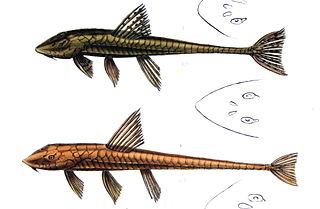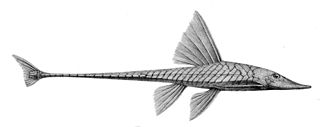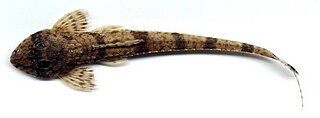
Hypostomus is a genus of catfish in the family Loricariidae. They are native to tropical and subtropical South America. H. plecostomus is the popular freshwater aquarium fish formerly known as Plecostomus plecostomus. The taxonomic structure of the Loricariidae is still being expanded by scientists. Hypostomus is a highly species-rich and widely distributed catfish genus.

Rineloricaria is a genus of freshwater tropical catfish belonging to the family Loricariidae. They are commonly called whiptail catfish because of the long filament that grows out of the tip of the caudal fin that is characteristic of the genus. With the exception of R. altipinnis from Panama, they are native to the rivers of northern and central South America. Some species are regularly seen in the aquarium trade.

Farlowella is a genus of fish in the family Loricariidae native to South America. This genus is broadly distributed in Amazon, Orinoco, Paraná and coastal rivers of the Guyana Shield. It is absent from the Pacific slope of the Andes and from the coastal rivers of the Brazilian Shield. Many of these species are kept in aquariums. This genus has a unique body shape that resembles a thin stick of wood. The body is slender and elongate, often with a pronounced rostrum and a brownish color with two lateral dark stripes beginning at the tip of the rostrum, passing over the eyes and ending at the tail, which are periodically interrupted on the caudal peduncle.

Loricariinae is a subfamily of the family Loricariidae of catfish. This subfamily is divided into two tribes and about 30 genera. They are mainly native to freshwater habitats in South America, but there are also several species in Panama and a single (Fonchiiichthys) in Costa Rica.
Limatulichthys is a genus of catfish in the family Loricariidae and the subfamily Loricariinae.
Pyxiloricaria menezesi is the only species of the monotypic genus Pyxiloricaria, a genus of the family Loricariidae of catfish.

Loricariichthys is a genus of catfishes of the family Loricariidae.

Sturisoma is a genus of armored catfishes native to Central and South America.
Harttia is a genus of armored catfishes native to South America.
Pareiorhaphis is a genus of catfish in the family Loricariidae native to South America. This genus can be readily distinguished from other neoplecostomines by the unique combination of having fleshy lobes on lateral margins of head ornamented with hypertrophied odontodes on nuptial males, caudal peduncle ovoid in cross section, abdomen usually naked, dorsal fin spinelet ovoid and adipose fin usually present. The color pattern is usually dark brown and mottled with the abdomen white. Most species in to Pareiorhaphis were originally described in Hemipsilichthys. In 1918, Alípio de Miranda-Ribeiro proposed the new genus Pareiorhaphis. Whether Pareiorhaphis is monophyletic or not is currently unknown.

Loricaria is a genus of armored catfish native to South America.

Neoplecostomus is a genus of fish in the family Loricariidae native to South America. Neoplecostomus can be distinguished from all other loricariids by a modified shield of small plates on the abdomen with posteriorly directed odontodes; the shield appears to act as a holdfast. The color pattern is generally mottled brown with the abdomen white. The head is long, rounded, and shovel-shaped. The fin spines are weak. They range from about 8 to 11 cm (3.1–4.3 in) SL. The species of Neoplecostomus live in fast-flowing water.
Pareiorhina is a genus of armored catfishes native to South America where they are only found in Brazil. These species are known to occur at altitudes above 650 metres (2100 ft) in various rivers of the Grande, Paraíba do Sul, São Francisco and Tietê River basins. This genus was first erected by Gosline in 1947 as a monotypic genus to include Rhinelepis rudolphi. It was not until 2003 that a second species, P. carrancas, was described. The third species, P. brachyrhyncha was described in 2005. Pareiorhina forms a monophyletic subunit with Neoplecostomus within the subfamily Neoplecostominae.

Sturisomatichthys is a genus of armored catfishes native to Central and South America.

Dasyloricaria is a genus of armored catfishes native to Central and South America. The distribution of these species includes the northwestern South America on the Pacific slope of Colombia and Panama. Its distribution is restricted to the Pacific slope of the Andes, which is a unique pattern of distribution within the subfamily.

Chaetostoma, also known as the bristlemouth catfish, is a genus of suckermouth armored catfishes native to South America with one species, C. fischeri, extending into Panama. Most species inhabit flowing rivers in the lower Andes and its foothills. Some species are kept in unheated aquaria.
Loricaria cuffyi is a species of catfish in the family Loricariidae. It is native to South America, where it occurs in the Essequibo River and Rio Negro basins in Guyana, as well as the Orinoco basin in Venezuela, with its type locality being designated as the Ireng River. The species was described on the basis of 36 specimens in 2020 by Alejandro Londoño-Burbano, Alexander Urbano-Bonilla, and Matthew R. Thomas. FishBase does not yet list this species.
Spatuloricaria tuira, commonly known as Tuira's whiptail or the marbled Xingu whiptail, is a species of catfish in the family Loricariidae. It is native to South America, where it occurs in the basins of the Xingu River and the Tapajós in Brazil. It is typically seen at the bottom of medium to large rivers with fast water flow and substrates composed of rocks or sand. The species reaches 46 cm in total length and can weigh up to at least 130 g.
Spatuloricaria terracanticum is a species of catfish in the family Loricariidae. It is native to South America, where it occurs in the Orinoco basin in Colombia. It is typically found in environments at elevations of 197 to 350 m above sea level with moderate slopes, turbid to slightly clear water, a conductivity of 30 to 302 μS/cm, oxygen concentration of 1.6 to 7.6 mg/L, oxygen saturation of 22.5% to 98.8%, pH of between 6.4 and 8.2, temperatures of 22.5 to 28.6 °C, and substrates composed of rocks and sand. The species reaches 28.6 cm in standard length.
Sturisomatichthys varii is a species of catfish in the family Loricariidae. It is native to South America, where it occurs in the San Juan River basin in Colombia. The species was described in 2019 by Alejandro Londoño-Burbano and Roberto E. Reis as part of a taxonomic revision of the genus Sturisomatichthys.











